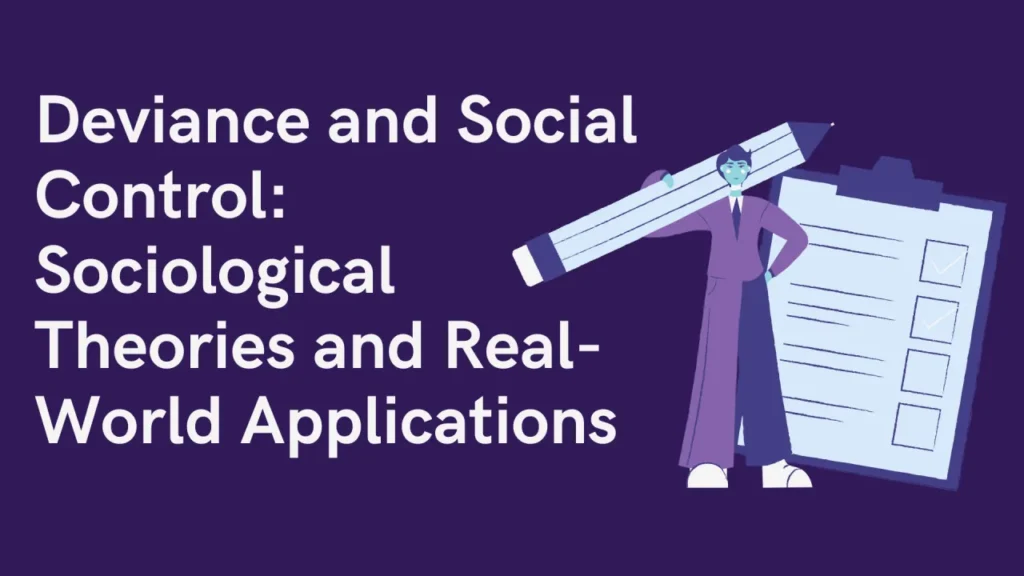Introduction
In the tapestry of human societies, deviance and social control are threads woven into the fabric of social life. They are as old as humanity itself, playing pivotal roles in shaping behaviors and maintaining order. But what exactly is deviance? How do societies control it? And why does it matter in our contemporary world? Let’s embark on an engaging exploration of these fascinating concepts, unraveling the theories behind them and their real-world applications.
What is Deviance?
Deviance, in sociological terms, refers to behaviors or actions that violate societal norms. These norms can be formal, such as laws, or informal, like unwritten social rules. What is considered deviant varies across cultures, time periods, and contexts. For instance, tattoos were once seen as deviant in many Western societies but have now become mainstream. Understanding deviance requires us to look beyond the act itself and consider the societal reactions to it.
Case Study: The Evolution of Marijuana Legalization
A contemporary example of changing perceptions of deviance is the legalization of marijuana. For decades, marijuana use was considered highly deviant and criminalized in many countries. However, with growing evidence of its medicinal benefits and changing public attitudes, numerous states in the U.S. and countries worldwide have decriminalized or legalized it. This shift highlights how societal norms evolve and how what is considered deviant can change over time.
Theories of Deviance
To comprehend deviance, sociologists have developed various theories. Each offers a unique lens through which to view and understand deviant behavior.
1. Structural Strain Theory
Developed by Robert K. Merton, the Structural Strain Theory posits that deviance arises when there is a disconnect between societal goals and the means available to achieve them. When people cannot attain societal goals through legitimate means, they may resort to deviance.
Example: Economic Inequality and Crime
Economic inequality can create structural strain. In societies where wealth and success are highly valued but opportunities are limited, individuals may turn to crime to achieve these goals. This theory helps explain why crime rates can be higher in economically disadvantaged areas.
2. Labeling Theory
Labeling Theory, proposed by Howard Becker, suggests that deviance is not inherent in any act but is instead the result of societal labels. When someone is labeled as deviant, they may internalize this label and continue the behavior.
Example: The Self-Fulfilling Prophecy
Consider a teenager labeled as a troublemaker by teachers and peers. This label may lead them to engage in more deviant behavior, fulfilling the prophecy set by the label. This theory underscores the power of societal labels in shaping individual identities and actions.
3. Differential Association Theory
Edwin Sutherland’s Differential Association Theory emphasizes the role of social interactions in learning deviant behavior. According to this theory, deviance is learned through interactions with others who engage in deviant acts.
Example: Gang Membership
Youth who grow up in environments where gang activity is prevalent may learn and adopt deviant behaviors through their associations with gang members. This theory highlights the significance of social context in the development of deviant behavior.
4. Social Control Theory
Travis Hirschi’s Social Control Theory focuses on the bonds individuals have with society. Strong bonds with family, school, and community can prevent deviant behavior. When these bonds are weak or broken, individuals are more likely to engage in deviance.
Example: School Dropouts
Students who dropout of school may have weaker social bonds and are at a higher risk of engaging in deviant behavior. Programs that strengthen these bonds, such as mentorship and community engagement initiatives, can reduce deviance.
Social Control: Mechanisms and Applications
Social control refers to the mechanisms societies use to regulate behavior and maintain order. These mechanisms can be formal or informal, involving laws, norms, and institutions.
Formal Social Control
Formal social control involves the use of laws and official institutions to regulate behavior. This includes the police, judicial system, and various governmental agencies.
Example: The Criminal Justice System
The criminal justice system is a primary tool of formal social control. It enforces laws, prosecutes offenders, and administers punishment. However, the effectiveness and fairness of this system can vary, leading to debates about reform and justice.
Informal Social Control
Informal social control relies on socialization, norms, and cultural expectations to regulate behavior. Families, schools, and peer groups play crucial roles in this type of control.
Example: Peer Pressure
Peer pressure is a powerful form of informal social control. Positive peer pressure can encourage individuals to conform to societal norms, while negative peer pressure can lead to deviance.
Real-World Applications and Relevance
Understanding deviance and social control is not just an academic exercise; it has real-world implications. Let’s explore how these concepts apply to contemporary issues.
Criminal Justice Reform
The theories of deviance can inform criminal justice reform efforts. For instance, recognizing the role of economic inequality in crime (Structural Strain Theory) can lead to policies that address underlying social issues rather than solely focusing on punishment.
Mental Health and Labeling
Labeling Theory highlights the importance of avoiding stigmatizing labels in mental health. Efforts to destigmatize mental illness and provide supportive environments can prevent individuals from internalizing negative labels and engaging in deviant behavior.
Community Policing
Social Control Theory supports the concept of community policing, where law enforcement builds strong bonds with the community. These bonds can enhance trust and cooperation, reducing deviant behavior and improving public safety.
Education and Youth Programs
Differential Association Theory underscores the importance of positive role models and environments for youth. After-school programs, mentorship, and community activities can provide alternative associations that discourage deviant behavior.
Technology and Cyber Deviance
In our digital age, deviance has taken new forms, such as cyberbullying, hacking, and online fraud. Understanding the social contexts and interactions that lead to cyber deviance can help develop effective prevention and intervention strategies.
Example: Cyberbullying
Cyberbullying is a growing concern, especially among teenagers. By applying the principles of Differential Association Theory, we can develop programs that promote positive online interactions and provide support to victims, reducing the prevalence of cyberbullying.
Conclusion
Deviance and social control are dynamic and complex concepts that shape our societies. By understanding the sociological theories behind them and their real-world applications, we gain valuable insights into human behavior and the mechanisms that maintain social order. As societal norms continue to evolve and new forms of deviance emerge, staying informed about these concepts remains crucial. Whether through criminal justice reform, mental health advocacy, community policing, or digital safety initiatives, applying these theories can help create a more just and cohesive society.








15 Responses
Great read! I appreciate the way you explain things so clearly.
You make even complex topics feel simple and approachable.
This was packed with valuable information.
I’m bookmarking it for future reference—so helpful!
Your writing always feels so real and grounded.
You’ve got such a beautiful way with words.
This post really made me stop and reflect.
You make even complex thoughts feel so relatable.
You write with such a calm, steady voice.
This post felt like a much-needed pause in my day.
Your words lingered with me long after reading.
Your writing is quietly powerful, always.
You make big thoughts feel simple and clear.
You explain things in such a clear and lovely way.
Loved the simplicity and honesty in this.
This article explained the topic so clearly that even a beginner like me could understand. I really appreciate how practical and easy-to-follow your advice was.
There’s a stillness in your words that allows the reader to hear their own thoughts more clearly. Your writing doesn’t shout; it simply is, and in that space, it allows for contemplation and introspection. It’s the kind of work that asks the reader to slow down, to take a breath, and to truly listen to what’s being said.